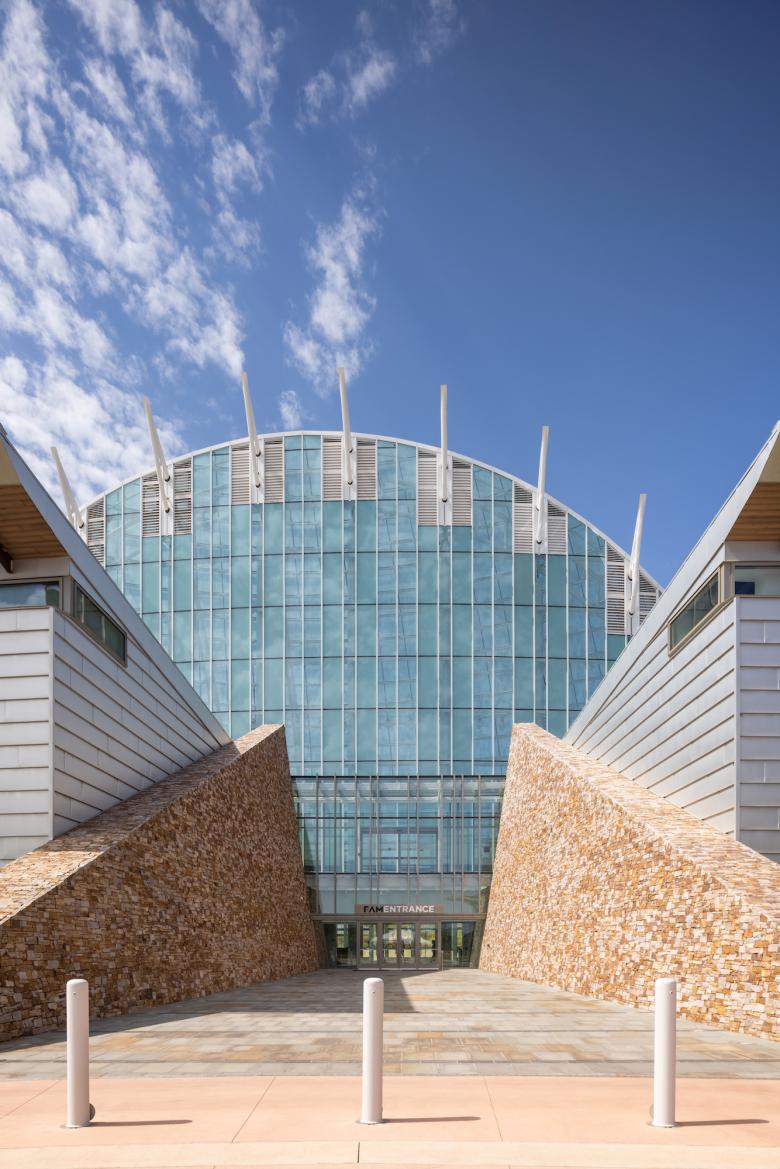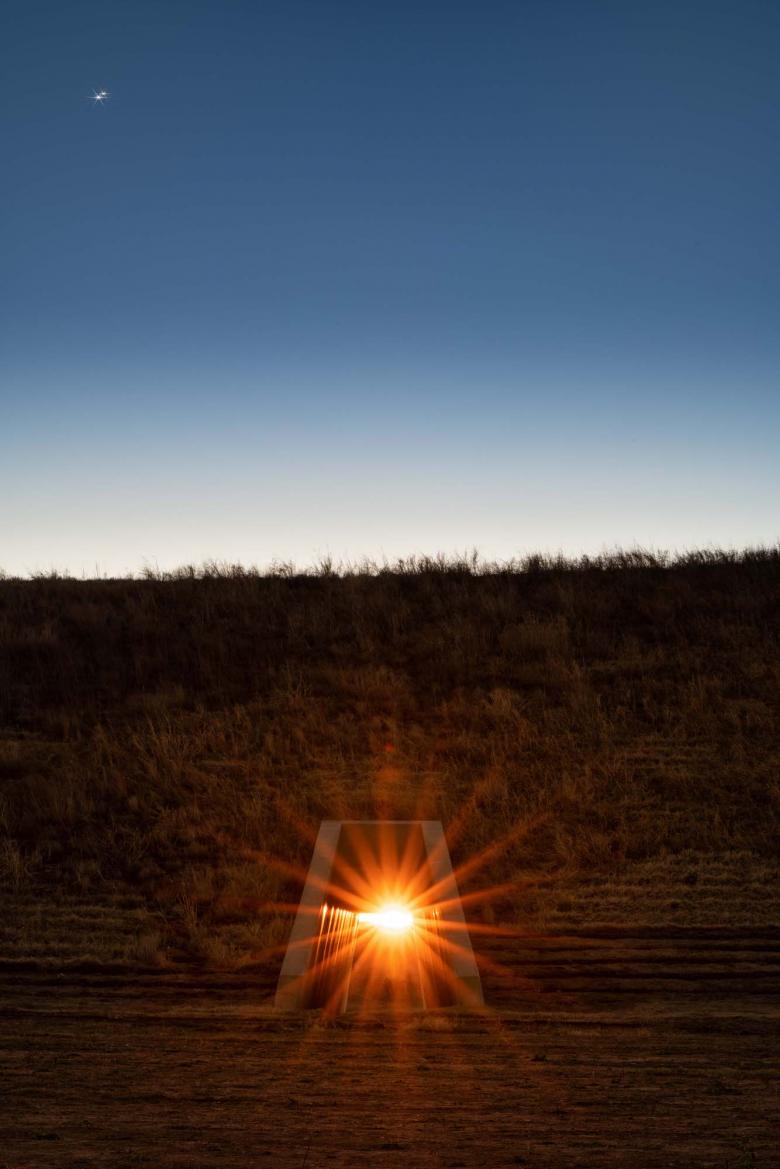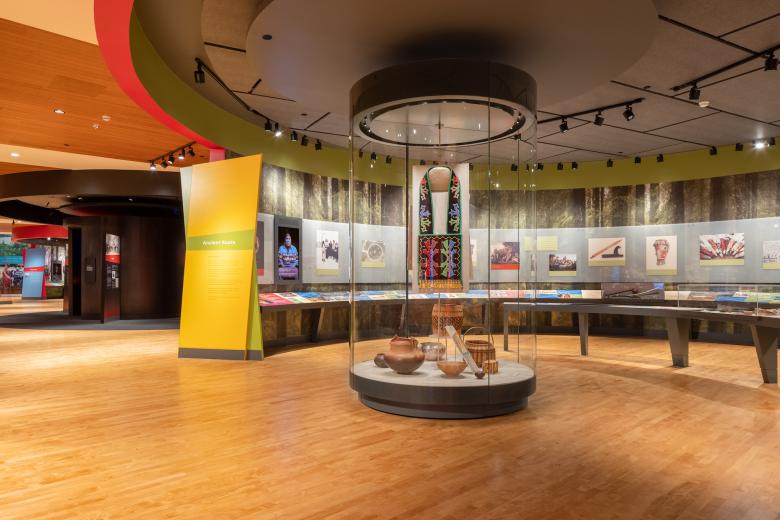US Building of the Week
First Americans Museum
Twenty-five years in the making, the First Americans Museum in Oklahoma City opened to the public in September 2021. Los Angeles's Johnson Fain started working on the project from 1996, developing a concept that honors the tribes in Oklahoma today and recalls historical tribes through an earthen mound at the center of the project. The architects answered a few questions about the First Americans Museum.
Location: Oklahoma City, Oklahoma, USA
Client: American Indian Cultural Center Foundation (AICCF)
Architect: Johnson Fain
- Design Principals: Scott Johnson, FAIA; William Fain, FAIA
- Project Architects: Daniel Janotta, AIA; Jen Spangler, AIA; Jed Donaldson, AIA
- Project Managers: Larry Ball, AIA; Doug Gardner, AIA
- Project Interior Designer: Suma Spina, AIA
- Technical Architect: Craig Lawrence, AIA
- Master Plan Architects: Juan Begazo, AIA; Robert Shaffer, AIA
Structural Engineers: Arup, KFC Engineering, Nabih Youssef Associates
MEP/FP Engineers: Darr & Collins, Stantec
Civil Engineers: Benham Group, Cardinal Engineering
Landscape Architect: Hargreaves Jones
Lighting Designers: Lighting Design Alliance, David Weiner Design
Exhibit Designer: Ralph Appelbaum Associates
Contractor: Centennial Builders (joint venture of Flintco and Manhattan Construction)
Construction Manager: ADG Architects
Native American Advisor: Don Fixico
Production Designer: Rick Carter
Institutional and Facility Programming: Lord Cultural Resources
Market and Project Economics: Harrison Price, Inc.
Site Area: 280 acres
Building Area: 175,000 sf
See bottom for Important Manufacturers / Products.
In 1996 Johnson Fain answered an RFP (Request for Proposals) from the State of Oklahoma for a new Indian Museum and Cultural Center. The RFP was soliciting site selection and master planning services. Site selection would take three years, and building design and construction another 22. During this time there were two separate RFPs, one for the site selection and master planning and the other for the building, landscape, and exhibit design, including documentation and construction administration for landscape and building. Documentation for the exhibit design was handled separately. Both required competitive proposals and interviews.
The concept for the museum, which honors 39 tribes in Oklahoma today, is a spiral mound in the form of a circle that begins in the earth and ascends to the heavens. That circle is intersected by a second circle forming the Hall of The People. The second circle is composed of two arcs: the western arc features permanent and rotating exhibitions, and the northern arc houses theaters, retail, dining, and other services necessary in modern museums. The Hall of The People is a 110-foot-tall glass prismatic structure that serves as both a starting point for visitors and a central gathering space. Its form is inspired by a Wichita grass lodge, and it features ten 26-inch-diameter columns to represent the ten miles per day that native people were forced to walk during the expulsion from their lands. Three “sky terraces” (Sun, Moon, Stars) are located along the spiral mound walk and are set back within the building envelope, offering views of the Oklahoma River and Downtown Oklahoma City.
During the site selection process, some of the elders suggested an earthen mound as the basis for the site plan. Historically, mound building was used by many tribes in the Americas to elevate the earth above dangerous flood levels. Fortuitously, several local construction projects needed to deposit 400,000 cubic yards of red earth fill — 45,000 truckloads. Given to the museum at no cost, the gift created the 1,000-square-foot diameter spiral FAM Mound rising to 90 feet at its peak that became the central element of the master plan.
While the spiral mound represents the earth and nature, the buildings express man-made technologies. The structures are clad in light-colored steel, which will become even lighter over time. Exterior corten steel railings will age to become a rust color, corresponding with the red earth of Oklahoma. The metal-clad roof of the permanent and changing gallery wings follows the curve of the FAM Mound walk; it is lifted and sloping to recall the appearance of wings on a soaring bird or a First American feather fan.
The entry procession starts from the east to greet the rising sun. A stainless-steel sculpture called “Touch to Above” (by father and son Cherokee artists, Demos Glass and Bill Glass, Jr.) welcomes visitors upon arrival into the courtyard. Flanking the entrance to the left side is the FAM Center, which features educational activities, and on the opposite side of the entry courtyard wraps the museum’s northern wing.
Arizona State University professor Donald Fixico, who was the project’s cultural and heritage advisor, shared with the design team the contrast of linear thinking in Western culture versus the holistic, non-linear ways of the natives, or as he calls it, a “circular” way for viewing the universe. Whereas Western culture values land as a commodity, native cultures give spiritual value to it, calling it “earth.” Circles relate to the cycle of life, the seasons, and the rotation of the earth. Reflecting the native tradition of a circular world view, the design evolved out of multiple circles suggested by arcs.
The natural world is at the heart of the First Americans Museum experience, both physically and spiritually. As opposed to a museum conceived around conventional notions of form and sequence, FAM acknowledges the elements of nature: earth, water, wind, and fire. The spiral mound represents the earth and frames Festival Plaza, where the winter solstice is marked through a passageway through the mound.
For thousands of years, native people have recognized the importance of the solstice. The entire project was designed to align with the cardinal directions and serve as a cosmological clock, commemorating and honoring the special times of equinox and solstice. The east-facing museum entrance framed by the stone walls aligns with the sunrise of the Vernal (March) and Autumnal (September) Equinoxes, with the sun rising directly in the center between the walls. During the Winter Solstice, the sun sets through the tunnel embedded into the FAM Mound; during the Summer Solstice, the sun sets at the peak of the mound.
FAM’s location was originally Oklahoma Drilling site #1 for the extraction of crude oil. One of the first steps in the remediation process was to cap the abandoned wells. The project team imagined a story about the site: that the land had been taken from the native peoples, stripped of its elements, and has now been returned to the First Americans, who restored it to the way it was.
The original landscape plan by Hargreaves Jones also called for cleanup and enhancement of the site, including the incorporation of native Oklahoma grasses and tree species. The harmonious relationship between the building and the surrounding landscape is critical to telling the authentic story of the 39 tribes in Oklahoma today.
Much of the earth works were put on hold because of insufficient funds to complete them.
As much of the building is built within the earthen mound, walls are insulated from changes in temperature. The earthen mound elevates the project above the flood plain. The site has been restored to its natural condition, i.e., capping of dozens of oil wells, removal of contaminants, and cleansing of soils.
The entrance to Hall of The People is framed by Remembrance Walls of Mesquabuck stone quarried from southeast Oklahoma. Mesquabuck stone is especially significant, as it carries the name of the Potawatomi Chief Mes’k wah-buk. Mes’k wah-buk refers to the red color of the sky at sunrise and sunset — the stone itself is characterized by its visible red and white strata. These two walls, which are 40 feet high, line a 113-foot-long walkway at the entrance of the building to honor the indigenous people who were forcibly removed from their tribal homelands as a result of the 1830 Indian Removal Act.
Email interview conducted by John Hill.
- Glass Curtainwall (Hall of The People): Novum Structures, TEPCOGLASS
- Metal Cladding Panels: Architectural Building Components (now McElroy Metal) “200 Series”
- Standing Seam Metal Roofing: Architectural Building Components (now McElroy Metal) “238T Structural”
- Glazing: Vitro Architectural Glass “Solarban 60”
- Doors — Entrances: Vetrotech/Saint-Gobain “VDS Curtain Wall”; Metal Doors: CURRIES Steel Doors and Frames; Wood Doors: VT Industries; Sliding Doors: Dormakaba “HSW-ES Sliding Glass Wall”
- Hardware — Locksets: Yale; Hinges: Assa Abloy/Pemko; Closers: Yale “PR4400”; Exit Devices/Pulls: Assa Abloy; Cabinet Hardware: Mockett
- Acoustical Ceilings: Armstrong World Industries, CertainTeed/Decoustics
- Suspension Grid: Armstrong World Industries
- Cabinetwork and Custom Woodwork: Fadco
- Paints and Stains: Benjamin Moore, Sherwin-Williams
- Wallcoverings: Keleen Leathers, KnollTextiles, Spinneybeck, Wolf-Gordon
- Wall Tile: Daltile; Revigrés
- Plastic Laminate: Formica, Panolam Surface Systems/Pionite, Wilsonart
- Special Surfacing: Caesarstone; Corian Solid Surface
- Resilient Flooring: FLEXCO
- Carpet: Bentley Mills, Mohawk Flooring, ShawContract
- Lighting—Interior ambient lighting: Tegan Lighting; Downlights: Gotham Lighting, Lucifer Lighting Company; Pendant: iGuzzini, Intense Lighting, Lucifer Lighting Company
- Elevators: Thyssenkrupp “Endura”













